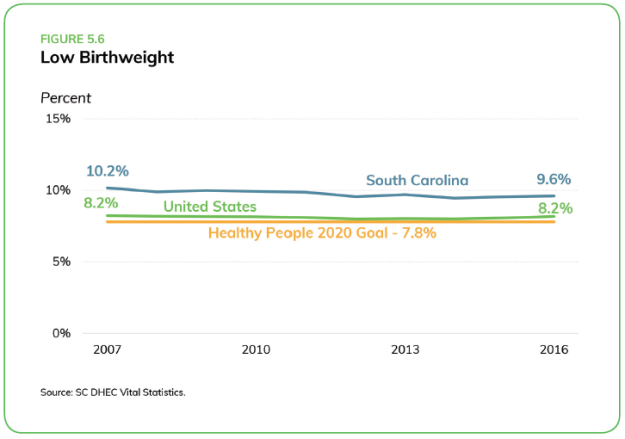Our next installment of the 2018 Live Healthy State Health Assessment summaries covers maternal and infant health. Because the document is 346 pages, we will summarize each section. Check out our previous posts: overview of the report, South Carolina demographics, leading causes of death and hospitalization, cross-cutting, and access to healthcare.
Infant Mortality
The five leading causes of infant death in South Carolina were:
- Birth defects (85%)
- Preterm birth and low birthweight (14.2%)
- Unintentional injuries (9.7%)
- Sudden Infant Death Syndrome (SIDS) (6.7%)
- Maternal complication of pregnancy (5.0%).
Targeted education and interventions focused on infant death prevention and contributing factors helps to reach audiences in greatest need. Although the infant mortality rate decreased from 8.5 deaths per 1,000 live births in 2007 to 7.0 deaths in 2016, this rate is higher than the national infant mortality rate and the Healthy People 2020 targeted goal.

Birth Defects
Babies affected by birth defects are at an increased risk for long-term physical, cognitive, and social challenges. Families affected by birth defects often deal with complex medical conditions that require surgery and early intervention services within the first three years of life. Approximately 8,074 birth defects were reported in South Carolina from 2009-2015. Birth defect types include: cardiovascular, central nervous system, chromosomal, orofacial, musculoskeletal, renal, genital, gastrointestinal, limb defects, and eye and ear defects.
Strategies to prevent birth defects include maintaining a healthy diet and consuming at least 400 micrograms of folic acid daily, regularly visiting a healthcare provider for chronic disease management and infection prevention, and avoiding exposure to drugs and alcohol.
Preterm Birth
Preterm birth is the live birth of a baby before 37 weeks of pregnancy. The earlier a baby is born, the greater the chances of having health problems in the short-term and long-term for the newborn. These health problems can include respiratory distress, bleeding of the brain, anemia, or other health issues.
In 2016, preterm birth in South Carolina was higher than the United States. The percent of preterm birth increased as the age of the mother increased. Approximately 14.7% of non-Hispanic Black women experienced preterm births.

Low Birthweight
Low birthweight is the birth of a baby weighing less than five pounds, eight ounces. Although some low birthweight babies are healthy, others may require special care at birth due to respiratory distress, intestinal complications, bleeding of the brain, or other health problems. Babies born at a low birthweight also have increased risk for developing chronic health conditions later in life.

Teen Birth
The birth rate for teenagers aged 15 to 19 has continuously declined since 1991, reaching historic lows across the United States. Success in the decline may be attributed to increased access to long-acting reversible contraception, delayed onset of sexual activity, and effective abstinence education. Although the teen birth rate has declined significantly from 2007 to 2016, South Carolina’s teen birth rate is higher than national rate.

For more information about South Carolina maternal health statistics on Sudden Infant Death Syndrome (SIDS), intended pregnancy, prenatal care, breastfeeding, and pregnancy-related death, read the full Maternal and Infant Health chapter of the 2018 State Health Assessment.









